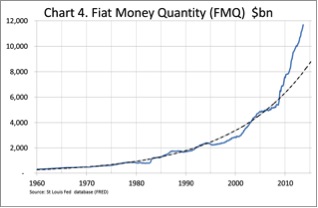Prior to 1933, the name “dollar” was used to refer to a unit of gold that had a weight of 23.22 grains. Since there are 480 grains in one ounce, this means that the name dollar also stood for 0.048 ounce of gold. This in turn, means that one ounce of gold referred to $20.67.
Observe that $20.67 is not the price of one ounce of gold in terms of dollars as popular thinking has it, for there is no such entity as a dollar. Dollar is just a name for 0.048 ounce of gold. On this Rothbard wrote,
No one prints dollars on the purely free market because there are, in fact, no dollars; there are only commodities, such as wheat, cars, and gold.[1]
Likewise, the names of other currencies stood for a fixed amount of gold. The habit of regarding these names as a separate entity from gold emerged with the enforcement of the paper standard.
Over time, as paper money assumed a life of its own, it became acceptable to set the price of gold in terms of dollars, francs, pounds, etc. (The absurdity of all this reached new heights with the introduction of the floating currency system).
In a free market, currencies do not float against each other. They are exchanged in accordance with a fixed definition. If the British pound stands for 0.25 of an ounce of gold and the dollar stands for 0.05 ounce of gold, then one British pound will be exchanged for five dollars.
This exchange stems from the fact that 0.25 of an ounce is five times larger than 0.05 of an ounce, and this is what the exchange of 5-to-1 means.
In other words, the exchange rate between the two is fixed at their proportionate gold weight, i.e., one British pound = five US dollars.
The absurdity of a floating currency system is no different from the idea of having a fluctuating market price for dollars in terms of cents.
How many cents equal one dollar is not something that is subject to fluctuations. It is fixed forever by definition. [2]
The present floating exchange rate system is a by product of the previously discredited Bretton Woods system of fixed currency rates of exchange, which was in operation between 1944 to 1971.
Within the Bretton Woods system the US$ served as the international reserve currency upon which all other currencies could pyramid their money and credit.
The dollar in turn was linked to gold at $35 per ounce. Despite this supposed link to gold, only foreign governments and central banks could redeem their dollars for gold.
A major catalyst behind the collapse of the Bretton Woods system was the loose monetary policies of the US central bank, which pushed the price of gold in the gold market above the official $35 per ounce.
The price, which stood at $35/oz in January 1970 jumped to $43/oz by August 1971 – an increase of almost 23%.
The growing margin between the market price of gold and the official $35 per ounce created enormous profit opportunity, which some European central banks decided to exercise by demanding the US central bank to redeem dollars for gold.
Since Americans didn’t have enough gold to back up all the printed dollars they had to announce effective bankruptcy and cut off any link between dollar and gold as of August 1971.
In order to save the bankrupt system policy makers have adopted the prescription of Milton Friedman to allow a freely floating standard.
While in the framework of the Bretton Woods system, the dollar had some link to the gold and all the other currencies were based on the dollar, all that has now gone. In the floating framework, there are no more limitations on money printing. According to Murray Rothbard
One virtue of fixed rates, especially under gold, but even to some extent under paper, is that they keep a check on national inflation by central banks. The virtue of fluctuating rates–that they prevent sudden monetary crises due to arbitrarily valued currencies–is a mixed blessing, because at least those crises provided a much-needed restraint on domestic inflation. [3]
Through policies of coordination central banks maintain synchronized monetary pumping so as to keep the fluctuations in the rate of exchanges as stable as possible.
Obviously, in the process such policies set in motion a persistent process of impoverishment through consumption that is not backed up by the production of real wealth.
Furthermore, within this framework if a country tries to take advantage and depreciate its currency by means of a relatively looser monetary stance this runs the risk that other countries will do the same. Consequently, the emergence of competitive devaluations is a surest way of destroying the market economy and plunging the world into a period of crisis.
On this Mises wrote,
A general acceptance of the principles of the flexible standard must therefore result in a race between the nations to outbid one another. At the end of this competition is the complete destruction of all nations’ monetary systems.[4]
[1] Murray N. Rothbard “The Case for a Genuine Gold Dollar,” in Llewellyn H. Rockwell, Jr., The Gold Standard: An Austrian Perspective (Lexington, Mass: D.C. Heath, 1985), pp. 1-17.
[2] Ibid.
[3] Murray N. Rothbard Making Economic Sense Mises Institute p 256.
[4] Ludwig von Mises, Human Action 3rd revised edition Contemporary Books, Inc p 791



